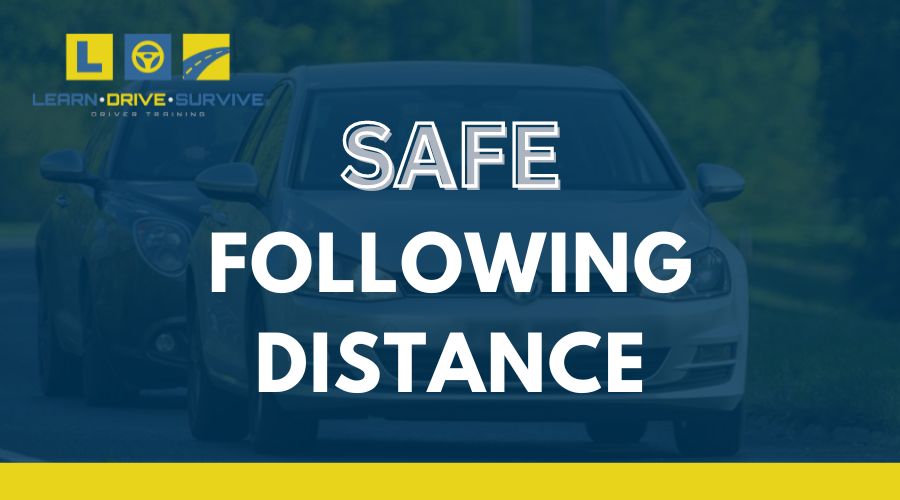What Is a Safe Stopping Distance?
Rear-end crashes are the most common crash type. This is because people drive too close to others when travelling in the same direction. If you are learning to drive with Learn Drive Survive, your instructor would have taught you how to keep a safe distance between yourself and the vehicle in front of you. This is called a safe following distance or 3 second gap. If you drive too close to the vehicle ahead of you, your chances of having a rear-end crash will drastically increase.
Learning how to effectively maintain a safe following distance and how increased distance can keep you safe, is also taught in the NSW Safer Drivers Course. Throughout the course, students will learn the importance of low-risk driving behaviours. This includes how and why maintaining a safe 3 second gap is paramount.
An important concept for any driver is understanding the importance of a safe 3 second following distance and the total stopping distance. There are several factors to consider when following another vehicle or motorcycle. These include;
- Your reaction time to a sudden situation in front of you
- The time it takes you to identify a situation and apply the brakes and;
- The time it takes to actually slow your vehicle and safely come to a complete stop
There’s More to Think About Than the Car in Front
A three (3) second gap, also referred to as your Crash Avoidance Space (CAS), is essential when in ideal conditions when driving in the same direction behind traffic. Remember, there are drivers who have slower reaction times than others. This is usually based on age. You need to consider the age of the vehicle and if it has an anti-lock brake system commonly known as ABS which is designed to prevent your wheels from “locking up” and resulting in a skid. ABS still allows the driver to steer safely in sudden or urgent situations.
Other factors to consider is the condition of your tyres and the road surface such as a gravel or wet road. Driving conditions like poor visibility and bad weather conditions can not only affect your judgment but your stopping distance. Many experienced drivers continually follow too closely. But regardless of their experience, following too close is likely to result in a rear-end crash. A safe driving course will teach you defensive driving techniques and how to stay safe on the road.
Statistics show that it takes about 1.5 seconds for approximately 90% of the population to respond to a sudden situation. This doesn’t include response times for intoxicated or fatigued drivers. This goes to show you that if you are only maintaining a 1 to 2 second gap from the vehicle in front, your chances of crashing into the back of the vehicle in front is high if it suddenly brakes.
ALL drivers must maintain a minimum following distance of at least 3 seconds. Safe drivers continually assess and re-asses their following distance. In adverse conditions such as rain, fog etc, always leave yourself at least four (4) seconds. Distance is your best friend when you need to stop suddenly!
How to Maintain a 3 Second Gap
The best way to determine how closely you’re following a vehicle is to select an object on the side of the road such as a parked car, pole, tree etc. From this object, you count one thousand and one, one thousand and two, one thousand and three. Each count represents one second. If you reach the stationary object within the 3 seconds, simply ease off the accelerator and re-assess until you reach the safe distance.
Keep a Safe Distance When Stopped
When stopped in traffic behind another vehicle, it is important that you leave a safe gap between your vehicle and the vehicle in front of at least 1 to 2 vehicles. The rule of thumb, is to make sure that you can clearly see about a metre of roadway along with the bottom of the rear tyres of the car in front, making contact with the road surface. This technique helps prevent the risk of being shunted forward into the vehicle in front. It also reduces the possibility of a crash due to the vehicle in front rolling back.
Want to Learn More About Defensive Driving & Safe Driving from Learn Drive Survive?
If you are a learner driver, you must continually practice driving at a safe distance to develop safe driving habits. If you want to learn safer driver techniques, book a Safer Drivers Course. Learn Drive Survive provide driving lessons for drivers of all abilities. If you are a NSW learner driver, why not take advantage of the NSW Safer Drivers Course? Not only will you receive an additional 20 hours in your logbook, you will also learn invaluable safe driving practices to help prepare you for a safe driving future.
Click here to book online or call 1800 898 969.



